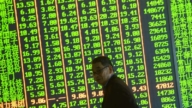【新唐人2014年07月25日訊】國際「渣打銀行」的研究專家日前估算,目前中國債務佔GDP的比重已經達到251%,突顯中國經濟面臨的巨大挑戰。中國整體經濟增長率不斷放緩,而債務不斷增加,專家認為,當前已經不可能再靠印製鈔票來解決金融危機,一旦危機出現,比較中國和其他西方經濟體所受的衝擊,在中國,吃虧的是民眾,而西方卻是政府在承擔。
「渣打銀行」(Standard Chartered)大中華區研究部主管王志浩(Stephen Green)在7月21號發表文章說,到6月底,中國總債務與國內生產總值(GDP)之比,達到251%,遠高於2008年底的147%,以及去年中共官方公布的215%。
旅美經濟評論家馬傑森:「都是猜測的數字,實際是多少,這是中共的國家機密,還有很多隱藏的債務。舉個例子,地方政府它不直接借貸,它建立一個公司,用這個公司借債,而這個公司的形式是千奇百怪,有地方政府獨立管理的,有合資的。」
中國金融智庫研究員鞏勝利透露,中共的人材工程、公關、統戰、文聯、作協以及中共從上到下的黨委開支,都會保密。
中國金融智庫研究員鞏勝利:「中國資產的黑洞到底有多大,只能預料,不能判斷,有些背後的那些就沒有計算進去,它公布的數據,通常是不包括黨的數據的,這個數據就很大很大。」
中國的經濟增長率不斷放緩,而債務卻不斷增加。從空蕩蕩的公寓樓群,到太陽能電池板、鋼鐵和水泥等眾多行業大規模產能過剩等,可以看出資本嚴重配置不當。
儘管如此,英國《金融時報》22號的文章說,中共政府因為擔心不斷放緩的經濟增長,和房地產市場的下挫,可能導致經濟「硬著陸」,不但沒有遏制信貸,反而允許信貸加快。報導說,6月份,中國新增信貸總計達到1萬9600億元人民幣,創下3月以來最高的月度數據,同比接近高出一倍。
中國全社會債務存在的風險,首先是,過度集中到了房地產領域。房地產貸款期限長,流動性極差,一旦泡沫破滅,不能及時變現,將快速放大金融風險。
第二個風險是「地方融資平臺債務」。「中國社科院」副院長李揚曾在去年發文指出,地方融資平臺的債務,大多數是在長達十年的過度追求GDP政績的情況下,盲目擴張的,主要集中投向城市基礎設施的建設,特別是大造新城,甚至「鬼城」,大造大廣場、超大型機場等上面。而地方債務投向特點是期限長、流動性差,而且回報非常之低,收入回報根本覆蓋不了債務本息。被外界稱為「永不到期的貸款和債務」。
除了中國以外,世界上少數幾個債務比率較高的經濟體,都是高收入經濟體。去年,美國的總債務與GDP之比大約是260%,而英國為277%,按照「渣打」的計算,日本以415%的比率在這方面領銜世界。
那麼,中國的負債和這些國家有甚麼不同呢?
傑森:「整個西方社會它們的債務根本原因是龐大的社會福利承諾,只要這些社會福利在萬不得已的情況下,稍微削減一點整個債務就會大幅度地減少,而中國這一點上大量是被貪官拿走了,一旦未來財政吃緊的時候,他會用它的權力去從百姓那裏掠奪更多,那個時候就是直接的社會的衝突,而美國這邊往往削減赤字的過程中,政府官員首先承擔第一手打擊。」
前年,中國城市房地產佔到GDP的385%。而在美國即使在2005年,房地產泡沫達到頂峰時,房地產總價值也只佔GDP比重的172%,最終卻引爆了2008年金融危機。
大陸經濟評論家牛刀指出,為了避免危機,中共又印製鈔票,來凝固鋼筋水泥。而貨幣嚴重超發後,再度直接引發通貨膨脹和房屋等資產價格上漲,使得經濟總量,過度依賴債務膨脹來壘高。
不過、儘管今年中共已經印製出接近GDP兩倍的鈔票,房價還是一直持續下滑。馬傑森認為,中國目前面臨的問題,已經無法靠印製鈔票來解決,種種跡象表明,中國經濟和政治上的問題都在向一個爆發點推進。
採訪編輯/劉惠 後製/李智遠
China’s Debt is 251 Times GDP – Western Comparisons
Standard Chartered Bank International experts recently
estimated that China's current debt-GDP ratio is 251%,
showing the enormous challenges faced by the Chinese economy.
China’s overall economic growth keeps slowing down,
while debt keeps increasing.
Experts believe it is impossible to rely on printing money
to solve the financial crisis.
Once the crisis comes to the surfaces, Chinese people will
suffer more compared with the crisis in Western economies
where the government takes the burden.
Standard Chartered Bank head of research for Greater China,
Stephen Green published an article on July 21, stating that:
China’s total debt to GDP ratio reached 251% at end of June,
far higher than 147% at the end of 2008, and 215%
published by Chinese Communist Party (CCP) in 2013.
US-based economic commentator Ma Jiesen:
“The figures are just estimates. The actual number is a CCP’s
state secret.
There are a lot of hidden debts. For example, a local
government can set up a company and get loans in the name
of this company.
These companies are run in different forms,
some are directly managed by the local government
and some are joint ventures."
China financial think tank researcher Gong Shengli revealed,
that expenses from top to bottom of the CCP,
human resources engineering, public relations, united front,
writers and CCP party committee are all kept confidential.
Gong Shengli: “How big is the black hole of China's assets
can only be estimated, not judged.
Some data behind the scenes are not included. The data CCP
publishes usually do not include the party's expenses, which
by itself are huge."
China’s economic growth keeps slowing down,
but the debt has continued to increase.
Empty apartment buildings and overproduction of solar panels,
steel and cement indicate serious misallocation of capital.
Nevertheless, British Financial Times's article on July 22
said Chinese government did not curb credit lending,
but allowed accelerated credit lending, for fear of possible
“hard landing" caused by slow economic growth and the
real estate market fall.
The reported said in June that China’s new credit reached
1.96 trillion yuan, highest since March and almost doubled
year over year.
The first risk from China’s overall debt is the over-concentrated
real estate field.
Real estate loans are long-term and with poor mobility.
Once the bubble bursts, it will quickly expand financial risks.
The second risk is the local financing platform debt.
Vice President of Chinese Academy of Social Sciences
Li Yang published an article in 2013 stating that:
the debt of local financing platform is mostly the result of
excessive pursuit of GDP in the last decade.
The main focus is construction of urban infrastructure,
especially large cities, or even “ghost towns,"
big squares and large airports.
The character of local debit is long-term with poor liquidity
and very low return.
The return on revenue simply cannot cover
the debt principal and interest, and referred to as
“loans and debt that never mature."
In addition to China, several of the few high debt ratio
economies are high-income economies.
Last year, U.S. debt to GDP was about 260%,
while the UK was 277%.
According to the Standard Chartered’s calculations,
Japan is the highest with 415%. So, what is the difference
between China and these countries?
Jason: “Western society’s main source of debt is
the huge commitment to social welfare. As long as social welfare
is reduced a little, debt will be cut a lot.
While in China corrupt officials take away the most.
When the financial situation tightens, corrupt officials use their
power to plunder more. It causes direct social conflicts.
When the U.S reduces the deficit, government officials are on
the front line."
Two years ago, China’s city real estate was 385% of GDP.
U.S. real estate was only 172% even during the real estate peak,
causing the 2008 financial crisis.
China’s critic Niu Dao pointed out that in order to avoid a crisis,
CCP printed money on steel and concrete.
Once currency is seriously inflated, it caused asset price hike.
The total economy is over-reliant on debt expansion.
Despite the CCP printing money twice as much as GDP,
housing prices continued to decline.
Ma Jiesen believes that issues in China cannot
be solved by printing money.
Signs indicate China’s economic and political issues
are going toward a breaking point.
Interview & Edit/LiuHui Post-Production /ZhiYuan Li



























